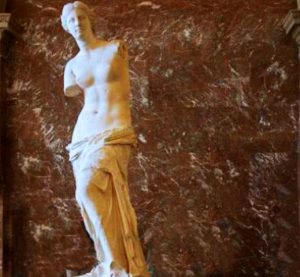How was discovered the statue of the famous Aphrodite of Milos

By chance, the French officer Olivier Boutier and two sailors of the French ship Estafet, who are in the bay of Milos for a few days’ visit, are near him. They admire the find and persuade him, pushing him to search for the other half of the statue as well. This is discovered after a while together with two “Hermes”, one young and one old, of Hermes and Hercules respectively. Today they are also found together with a third one and Aphrodite in the Louvre Museum.
Boutier immediately understood the artistic value of the statue and painted it, while at the same time informing his governor and Louis Mprest, vice-consul of France in Milos, to negotiate its purchase.
Thus, a first agreement is concluded with the Center, until the French ambassador in Istanbul is informed. He receives messages from many. Nathan d’Ourville, a French officer, who saw it after a few days (April 19, 1820), speaks enthusiastically to him. Boutier describes it in his best words, while Louis Prest’s letter is in his hands.
So with all this information he decides to acquire the famous statue. For this purpose he sends the third secretary of his Embassy, the Comte de Marseilles, to Milos, to carry out this purchase. He succeeds under adverse conditions, however, because Kentrotas, under the pressure of the pre-eminent people of the island, had sold it to a certain Pope-Makarios Bergis.
He bought it on behalf of the dragoman of the Turkish fleet, Prince of Moldavia, Nikolaou Mourouzis. Finally it remains in the hands of the French ambassador Marquis de Pivier, who donated it on March 1, 1821 to the King of France, Louis XVIII, to be placed in the Louvre and become the object of admiration and ecstasy of millions of people.
Since then, many studies have been done and a lot has been written about this famous masterpiece of art, while many questions tormented and still torment the experts. Problems such as the date of its creation, the name of the sculptor, the position where it was found, if it was a complex with the god Mars and others, demand answers.
But it is considered certain that it is from the Hellenistic era, i.e. younger than 323 BC. with a more likely date between 150-50 BC, and even more certain that it is a work of art with global radiation, showing the culture and sensibilities of the Ancient Greeks, and indeed of the Melians.
